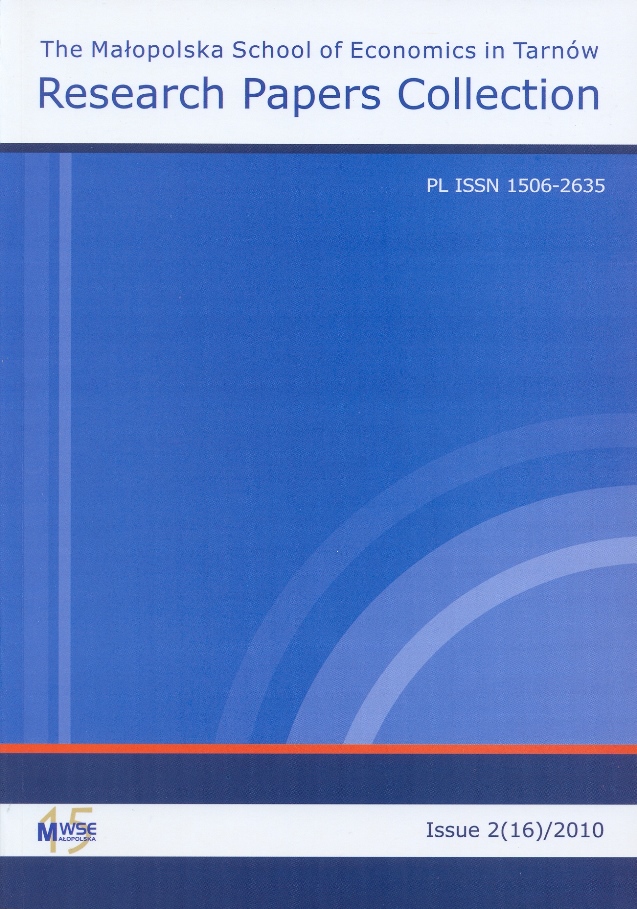Abstract
The article presents a discussion around the essence and meaning of the entrepreneur’s business model and its components. Further, the article provides and characterises seven classification systems that cover all the features of corporate owners: legal status, economic goal, contribution to the realisation of a business idea, investment horizon, participatory rate, attitude to risk and the most important—theirs role in creating business model. The article characterises the dualistic and monistic system of management and supervision in an enterprise. It stresses their grave importance for the owner’s supervision, as well as for operations of the enterprise. Through a comparative analysis of both systems the conditions of applying them are indicated, as are the assumptions to use one of them.
References
Bieniak J., Bieniak M. 2005. Spółka akcyjna. Komentarz. Warszawa: Wydawnictwo C.H. Beck. ISBN 83-7387-664-2.
View in Google Scholar
Cejmer M., Napierała J., Sojka T. (ed.). 2006. Corporate governance. Europejskie Prawo Spółek. Vol. 3. Kraków: Wolters Kluwer Polska. ISBN 83-7444-422-3.
View in Google Scholar
Chesbrough H., Rosenbaum R.S. 2000. The role of the business model in capturing value from innovation (working paper). Boston: Harvard Business School.
View in Google Scholar
Donath R. 1999. “Taming e-business models”. ISBM business marketing web consortium 3 (1). State College (PA). Institute for the Study of Business Markets, pp. 1–24.
View in Google Scholar
Gołębiowski T., Dudzik T.M., Lewandowska M., Witek-Hajduk M. 2008. Model biznesu polskich przedsiębiorstw. Warszawa: Wydawnictwo Szkoły Głównej Handlowej. ISBN 978-83-7378-347-8.
View in Google Scholar
Gordijn J., Akkermans J., Van Vlier J. 2001. “Designing and evaluating e-business models”. IEEE Intelligent Systems, vol. 16 (4), pp.11–17.
View in Google Scholar
Hedman J., Kalling T. 2003. “The business model concept. Theoretical underpinnings and empirical illustrations”. European Journal of Information Systems, vol. 12, pp. 49–59.
View in Google Scholar
Heubischl J. S. 2006. European network governance. Corporate network systematic in Germany, The United Kingdom and France: An empirial investigation. Doctoral thesis. Tutor prof. M. Saat. Tallinn: TUT Department of Business Administration.
View in Google Scholar
Hilb M. 2006. “Corporate governance”. In: Corporate governance. EBS Review, no. 21 (1) Tallinn: Estonian Business School.
View in Google Scholar
Idenburg P.J. 1993. “Four styles of strategy development”. Long Range Planning, vol. 26, iss. 6, p. 132.
View in Google Scholar
Jeżak J. 2001. “Zarządzanie przedsiębiorstwem zorientowane na wzrost wartości dla jego właścicieli”. Przegląd Organizacji, no. 5.
View in Google Scholar
Johnson M.W., Christensen C.M., Kagermann H. 2008. “Reinventing your business model”. Harvard Business Review, vol. 86, iss.12, p. 51.
View in Google Scholar
Kozioł L. 2010. “Rola instytucji nadzorczych i zarządczych w kształtowaniu strategii przedsiębiorstwa”. In: Zarządzanie strategiczne: Strategie organizacji. Ed. R. Krupski. Wałbrzych: Wydawnictwo Wałbrzyskiej Wyższej Szkoły Zarządzania i Przedsiębiorczości. ISBN 978-83-60904-12-1.
View in Google Scholar
Lis K.A., Sterniczuk H. 2005. Nadzór korporacyjny. Kraków: Oficyna Ekonomiczna. ISBN 83-89355-83-3.
View in Google Scholar
Monitor Europejski. 2009. Warszawa: Urząd Komitetu Integracji Europejskiej. Departament Dokumentacji Europejskiej. ISSN 1732-8268, no. 51.
View in Google Scholar
Morris M., Schindehutte M., Allen J. 2005. “The entrepreneur’s business model: Toward a unified perspective”. Journal of Business Research, vol. 58, iss. 6, p. 726.
View in Google Scholar
Muszyński M. 2006. Aktywne metody prowadzenia strategii przedsiębiorstwa. Warszawa: Placet. ISBN 83-7488-105-4.
View in Google Scholar
Nogalski B. 2009. “Rozważania o modelach biznesowych przedsiębiorstw jako ciekawym poznawczo kierunku badań problematyki zarządzania strategicznego”. In: Zarządzanie strategiczne: Problemy, kierunki badań. Ed. R. Krupski. Prace Naukowe Wałbrzyskiej Wyższej Szkoły Zarządzania i Przedsiębiorczości. Wałbrzych: Wydawnictwo Wałbrzyskiej Wyższej Szkoły Zarządzania i Przedsiębiorczości. ISBN 978-83-60904-05-3.
View in Google Scholar
O b ł o j K. 2002. Tworzywo skutecznych strategii: Na styku starych i nowych reguł konkurowania. Warszawa: Polskie Wydawnictwo Ekonomiczne. ISBN 83-208-1412-X.
View in Google Scholar
Order of the Council (EC) no. 2157/2001 of 8th October 2001 on the Statute of the European Company (SE) J. L. U E L 294/1.
View in Google Scholar
Pasieczny J. 2005. “Pułapki krótkookresowej racjonalności”. Master of Business Administration, no. 6 (77).
View in Google Scholar
Senge P. 2002. Piąta dyscyplina: Teoria i praktyka organizacji uczących się. Transl. by H. Korolewska-Mróz. Kraków: Oficyna Ekonomiczna. ISBN 83-88597-68-X.
View in Google Scholar
Siemiątkowski T. 2005. “Monistyczny model ładu korporacyjnego w spółce europejskiej jako alternatywny system zarządzania i nadzoru w korporacji”. In: Wolność gospodarcza: Wybrane zagadnienia prawne. Ed. Z. Niewiadomski. Studia i Prace Kolegium Zarządzania i Finansów. ISSN 1234-8872, no. 57. Warszawa: Wydawnictwo Szkoły Głównej Handlowej w Warszawie.
View in Google Scholar
Slywotzky A.J. 1996. Value migration. Boston: Harvard Business Review Press. ISBN 0875846327.
View in Google Scholar
Sułkowski Ł. 2009. “Myślenie strategiczne ‘trzeciego szympansa’”. In: Zarządzanie strategiczne: problemy, kierunki badań. Ed. R. Krupski. Wałbrzych: Wydawnictwo Wałbrzyskiej Wyższej Szkoły Zarządzania i Przedsiębiorczości. ISBN 978-83-60904-05-3.
View in Google Scholar
Thomsen S., Petersen T. 2000. “Ownership structure and economic performance in the largest European companies”. Strategic Management Journal, vol. 21, iss. 6, p. 689.
View in Google Scholar
Ustawa z dnia 4 marca 2005 r. o europejskim zgrupowaniu interesów gospodarczych i spółce europejskiej.
View in Google Scholar
Dz. U. z 2005 r. nr 62, poz. 551, zm. Dz. U. z 2005 r. nr 183, poz. 1538, Dz. U. z 2006 r. nr 149, poz. 1077.
View in Google Scholar
Wolf J. B. 1999. The effects of agency problems on the financial behavior, performance and efficiency of German industrial stock corporations. Peter Lang Europaischer Verlag der Wissenschaften. ISBN 0820432415.
View in Google Scholar
© Copyright by Małopolska School of Economics in Tarnów. The articles are available under the Creative Commons Attribution NonCommercial-NoDerivatives 4.0 International License


